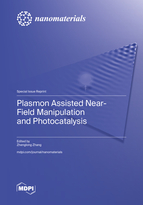Plasmon Assisted Near-Field Manipulation and Photocatalysis
A special issue of Nanomaterials (ISSN 2079-4991). This special issue belongs to the section "Energy and Catalysis".
Deadline for manuscript submissions: closed (30 September 2022) | Viewed by 20393
Special Issue Editor
Interests: nano-optics; tip-enhanced Raman spectroscopy; single-molecule near-field photocatalysis; tip-enhanced nonlinear effect; new micro-nano photothermal devices.
Special Issue Information
Dear Colleagues,
As a new class of photocatalysts, plasmonic noble metal nanoparticles with the unique ability to harvest light energy across the entire visible spectrum and produce effective energy conversion have been explored as a promising pathway for the energy crisis.
We are pleased to invite you to make an excellent contribution to the present special issue. This issue would like to overcome the “Plasmon Assisted Catalysis” as limited to theoretical and experimental results and advances on the plasmonic catalysis on molecules and nanomaterials, rather providing information on the traditional catalytic methods of molecules and materials.
This Special Issue aims to promote clear understanding of plasmonic catalysis on both molecules and materials and contribute to the design of highly tunable catalytic systems to achieve efficient solar-to-chemical energy conversion. Novel results on plasmonic electromagnetic field, hot electrons, or photothermal catalyzed chemical reactions and mechanism discussion on plasmon excitation and energy transfer will be welcome, as well as critical review articles challenging the present knowledge and offering an expert platform to discussion.
In this Special Issue, original research articles and reviews are welcome.
We look forward to receiving your contributions.
Prof. Dr. Zhenglong Zhang
Guest Editor
Manuscript Submission Information
Manuscripts should be submitted online at www.mdpi.com by registering and logging in to this website. Once you are registered, click here to go to the submission form. Manuscripts can be submitted until the deadline. All submissions that pass pre-check are peer-reviewed. Accepted papers will be published continuously in the journal (as soon as accepted) and will be listed together on the special issue website. Research articles, review articles as well as short communications are invited. For planned papers, a title and short abstract (about 100 words) can be sent to the Editorial Office for announcement on this website.
Submitted manuscripts should not have been published previously, nor be under consideration for publication elsewhere (except conference proceedings papers). All manuscripts are thoroughly refereed through a single-blind peer-review process. A guide for authors and other relevant information for submission of manuscripts is available on the Instructions for Authors page. Nanomaterials is an international peer-reviewed open access semimonthly journal published by MDPI.
Please visit the Instructions for Authors page before submitting a manuscript. The Article Processing Charge (APC) for publication in this open access journal is 2900 CHF (Swiss Francs). Submitted papers should be well formatted and use good English. Authors may use MDPI's English editing service prior to publication or during author revisions.
Keywords
- Plasmonic catalysis
- Surface plasmon resonance
- Enhanced electromagnetic field
- Hot carrier transfer
- Photothermal effect
- Molecular reaction
- Nanomaterial growth
- Crystal transformation







